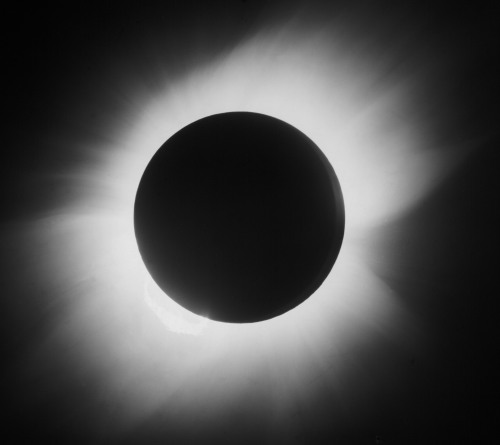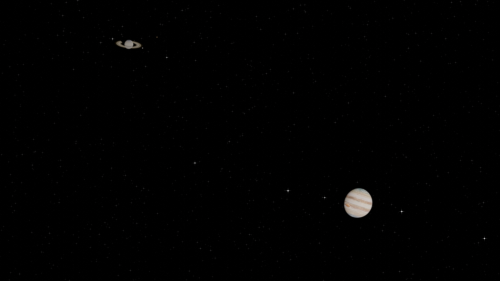
99 posts
Latest Posts by astrorelations - Page 2

Jason Anderson
British artist Jason Anderson creates colorful abstract paintings composed of pixelated swatches of pastel-toned oil paint. Up-close, the artist’s paintings look like blocky layers of shapes and color; but, from afar, his scenes—featuring cityscapes, roads, trains, and marinas—are revealed.


Anderson began his career as a stained glass apprentice, where he worked on restoring the windows of cathedrals. He soon progressed onto designing the glass murals himself, where he learned how to break down subject matter into “jigsaws” of colored sections. This approach still shines through in his paintings today—complex scenes are brought to life with simple shapes and careful consideration to hue and tone.







Hi! Can you tell some uni or colleges math resources?
Can you be more specific? Like resources for studying for particular undergrad level classes?
A few “classic” online references:
Paul’s online math notes (https://tutorial.math.lamar.edu/): algebra, calc 1-3, diff eqs though I’ve mostly only used the calc ones. A common favorite
Khan Academy: haven’t actually used any of their math stuff for years but I remember their videos were good
3blue1brown: he has a series on calc, diff eqs, and linear alg. I haven’t actually watched many of these either but his videos are generally good and I know people who like the series in particular
If you mean higher level math, I tend to just use a search engine and end up referencing a mix of wikipedia, wolfram mathworld, random pdfs from various universities, and math stack exchange. And of course textbook pdfs
If you give me more details, I’ll see if I can think of anything else!


Euler’s identity - beauty in its purest form.






Crush by Richard Siken // Two Girls in Bed by Henri De Toulouse-Lautrec // “Washing Machine Heart” by Mitski // David Altmejd // Wasted by Marya Hornbacher // Embrace Painting by Peter Wever

Hi guys, I made an instagram with images of space (nebulae, galaxies, etc) @wonders_of_the_cosmos | Twitter: @wotcosmos
Orbit change of artificial satellite
In order to raise the altitude of an artificial satellite, it is necessary to accelerate it. When the orbital speed increases, the centrifugal force generated by the rotation of the satellite becomes stronger than the gravity of the earth applied to it, then the altitude rises. At this time, a certain amount of energy is returned from the satellite to the vacuum space to reduce the energy debt. Hence the orbital speed decreases and finally drops below the initial speed. The sum of the reduced amount of the momentum energy and the energy required for the acceleration is returned to the vacuum space.

In order to lower the altitude of an artificial satellite, it is necessary to decelerate it. When the orbital speed decreases, the centrifugal force becomes weaker than the gravity, then the altitude drops. At this time, the satellite is given a certain amount of energy from the vacuum space. Hence the orbital speed increases and finally rises above the initial speed. The sum of the increased amount of the momentum energy and the energy released by the deceleration is borrowed from the vacuum space.

Potential energy is energy debt borrowed from vacuum energy bank
Potential energy is defined as the energy difference between the energy of an object at a current position and the energy of the object at a reference position (generally, infinitely distant position) in a force field.
The gravitational potential energy of a combination of an object with mass M and another object with mass m separated by distance R is expressed by the following formula using the gravitational constant G.

The potential energy is zero when the distance between objects is infinite, and the negative energy increases as the distance decreases by gravity.
Because there can be no negative energy in the real space, potential energy should be considered as fictitious energy. Regarding potential energy as “energy debt” is easy to understand. Then what do objects borrow energy from? The answer is the vacuum space. Potential energy is the energy debt borrowed from “the vacuum energy bank”. An increase in the negative energy means an increase in the energy given by the vacuum space.
Therefore, the law of conservation of energy is established only when the vacuum energy is counted.
When an object is attracted to another object by gravity, a certain amount of energy is given to it from the vacuum space. Hence its energy debt increases by the amount given from the vacuum space, and its momentum energy increases then it accelerates.

On the contrary, when applying a force to an object and moving it against gravity, it returns a certain amount of energy to the vacuum space. Hence the energy debt decreases by the amount returned to the vacuum space, and its momentum energy decreases then it decelerates from the initial speed.

We say “potential energy increases” when the energy debt decreases, but we should say “potential energy decreases”.


Titan Moon of Saturn
Image credit: NASA/JPL (precessed by Stuart Rankin and Mike Malaska)




Patreon | Ko-fi
'Lost in Math: How Beauty Leads Physics Astray' - A Review
‘Lost in Math: How Beauty Leads Physics Astray’ – A Review
Lost in Math is Sabine Hossenfelder’s book challenging physicists’ preference for elegant theories over experimental results. Discover how this can lead to dead end research that misleads the public. I have mixed feelings about YouTube. The good news about the video site is that anybody can start a TV channel there. The bad news is that anybody can start a TV channel there. There’s a tremendous…

View On WordPress
Why the World’s Best Mathematicians Are Hoarding Chalk
"I calculated how many boxes I would need to last ten years."
#youwould





Mars
Energy formulas for imaginary matter
An imaginary matter is the mirror image of the corresponding real matter.
Energy formulas for real matters are still useful for imaginary matters if an observer is in the imaginary space. Then how are energy formulas for imaginary matters expressed if an observer who is in the real space could observe imaginary matters?
Suppose that observer A is in the real space and observer B is the mirror image of observer A in the imaginary space.
The space velocity vector and spacetime velocity vector measured by observer A are the opposite of those measured by observer B in the same way that the left and right sides of the mirror image are swapped, i.e., the space speed measured by observer A is constant at the maximum speed c and the spacetime speed measured by observer A is variable.
The relationship of these velocity vectors are shown in the figure below.

Assuming an imaginary matter moves at speed vi measured by observer B, the space speed vsB, time speed vtB and spacetime speed vstB measured by observer B are as follows:

On the other hand, the space speed vsA, time speed vtA and spacetime speed vstA measured by observer A are as follows:

The following equation holds true for time speed.

Hence, the following formula is obtained for the spacetime speed measured by observer A.

The spacetime speed measured by observer A is smaller as the space speed measured by observer B is larger.
Real matters cannot move at the speed of light at the cost of having mass, while imaginary matters also have mass but move at the speed of light.
Mass energy vector is in the time axis of the space-time complex plain and the time axis is common between the real space and imaginary space. Hence, the magnitude of mass energy vector is invariant for the spatial inversion. The imaginary space axis is at right angles to the real space axis in the space-space complex plain.

Therefore, the mass energy of imaginary matter measured by observer A is expressed as follows:

where “−i” is the operator that transfers from the real space to the imaginary space and m is mass.
The energy formulas for real matters in the range of v>c express those for imaginary matters, but the energy formulas of total energy and momentum energy are exchanged for each other. Therefore, the momentum energy Es and total energy Est of imaginary matter measured by observer A are expressed as follows:

For an imaginary matter at rest (vi = 0),

The space speed of imaginary matters is always zero because they have no momentum energy. Hence, an imaginary matter is equivalent to the real matter with (square root of 2) times the mass of the imaginary matter, moving at the speed of light.
The space velocity and time velocity of real matter, light and vacuum energy and those of imaginary matter converted into the real space are arranged below.
・Real matter : relative space speed and relative time speed ・Light : absolute space speed and no time velocity ・Vacuum energy : neither space velocity nor time velocity ・Imaginary matter : absolute space speed and absolute time speed

This is the Mesha Stele. Written around 850 BCE, it was commissioned by King Mesha of Moab, a small nation around what is today Jordan. The basalt stele describes how Chemosh, the god of Moab, had previously been angry with his people and had allowed them to be subjugated to Israel but he eventually returned to his people and helped them gain their freedom from Israel. The stone then details King Mesha’s building projects.
The Mesha Stele roughly agrees with the Israelites version of events in the Books of Kings (2 Kings 3:4–8). Which makes it really, really important historically. The stele is also the most extensive inscription ever recovered that refers to the kingdom of Israel and it bears the earliest certain reference to the Israelite god Yahweh outside of the Bible itself.










'Giant Saucer Stones' Landscape Feature, Boulsworth Hill, Briercliffe, Lancashire.
Happy Pi Day!
Nikola Tesla aka “Mr. π / 2 ( c )”

From June 1, 1899 to January 7, 1900, Nikola Tesla conducted experiments and research on high voltage and high frequency electricity to prove his theory of world wireless energy transmission. His previous 10 years of lectures, experiments, and research prior to this expedition had prepared him to further explore the most complex electrical forces any human had previously ever faced in history.
He chose Colorado Springs, CO as the location due to the high elevation and low air pressure suitable for electrical experimentation. Also, because this was a far more sparsely populated and open area compared to his lab in New York, he was free to experiment with the more extreme parameters of electricity.
With his new and improved Tesla coils that he had invented previously, which could produce electrical power up to millions of horsepower, he was set to challenge the limits of electricity. It’s clear from Tesla’s notes that his principle initiative was to find ways to manipulate the forces of nature and to utilize them for the advancement of humankind. In his Colorado Springs Notes text, he expressed that he had three main goals:
1. To develop a transmitter of great power.
2. To perfect means for individualizing and isolating the energy transmitted.
3. To ascertain the laws of propagation of currents through the earth and the atmosphere.
In his seven months of work, not only did he accomplish all three goals and prove his theory of wireless energy transmission, but he made some of the most remarkable experiments in scientific history. He obtained voltage and frequencies in the hundreds of millions of horse power–producing sparks over 100 feet in length, and actually sent energy through the earth itself to light multiple lamps which were placed dozens of miles away from his transmitter. He discovered stationary waves deriving from natural lightning discharges which his receiver could detect hundreds of miles away from his station. This discovery proved that power could indeed be transmitted through the earth to far distances. He also discovered that the earth as a whole had certain periods of vibrations, and by using his large oscillator could impress electrical vibrations at the same periods upon it creating more energy within the earth. This process is now referred to as constructive interference (the interference of two or more waves of equal frequency and phase, resulting in their mutual reinforcement and producing a single amplitude equal to the sum of the amplitudes of the individual waves). By doing this repeatedly using massive amounts of energy unheard of before, Tesla was able to transmit energy from his transmitter around earth and back to his receiver traveling at a mean velocity of 292,815 miles per second. Over 100,000 mps faster than light. Many electrical experimenters have proven this velocity including Jonathan Zenneck and Arnold Sommerfeld. The mathematical equation to this speed is pi divided by 2 times the speed of light.
v = π / 2 ( c )
v = average velocity of Tesla’s electrical current round earth (miles per second)
(you can plug in any metric and get same results)
c = speed of light (miles per second)
v = π / 2 (186,300)
v = 1.57 (186,300)
v = 292,491

The speed of light is a constant, it is not a limit. The velocity of light is an expression of the ratio of energy to mass. Tesla’s waves worked on different dimensions. The electromagnetic waves we use in today’s technology travel at the speed of light, but due to the nature of these waves (which are similar to light), they diminish with distance. This is because their electromagnetic lines of force and their magnetic lines of force intercept the angles of one other, causing resistance (radiation resistance). This is also why they eventually lose energy. Tesla, on the other hand, used an oscillating wave, or a longitudinal wave, in which the electromagnetic and magnetic forces run parallel with each other (hence there is no friction or loss of energy). As a result, the more power he used, the faster and further these waves would travel. Imagine what can be accomplished with waves that do not diminish with distance!
Witnessing this experiment, space, according to Tesla, was completely annihilated. This meant he could potentially throw the globe into oscillations of such magnitude that massive amounts of energy could be created, collected, and transmitted to any point on earth regardless of distance.

the limits of the universe

Silence
What is a Wormhole?
Wormholes were first theorized in 1916, though that wasn’t what they were called at the time. While reviewing another physicist’s solution to the equations in Albert Einstein’s theory of general relativity, Austrian physicist Ludwig Flamm realized another solution was possible. He described a “white hole,” a theoretical time reversal of a black hole. Entrances to both black and white holes could be connected by a space-time conduit.

In 1935, Einstein and physicist Nathan Rosen used the theory of general relativity to elaborate on the idea, proposing the existence of “bridges” through space-time. These bridges connect two different points in space-time, theoretically creating a shortcut that could reduce travel time and distance. The shortcuts came to be called Einstein-Rosen bridges, or wormholes.

Certain solutions of general relativity allow for the existence of wormholes where the mouth of each is a black hole. However, a naturally occurring black hole, formed by the collapse of a dying star, does not by itself create a wormhole.
Wormholes are consistent with the general theory of relativity, but whether wormholes actually exist remains to be seen.

A wormhole could connect extremely long distances such as a billion light years or more, short distances such as a few meters, different universes, or different points in time
For a simplified notion of a wormhole, space can be visualized as a two-dimensional (2D) surface. In this case, a wormhole would appear as a hole in that surface, lead into a 3D tube (the inside surface of a cylinder), then re-emerge at another location on the 2D surface with a hole similar to the entrance. An actual wormhole would be analogous to this, but with the spatial dimensions raised by one. For example, instead of circular holes on a 2D plane, the entry and exit points could be visualized as spheres in 3D space.

Science fiction is filled with tales of traveling through wormholes. But the reality of such travel is more complicated, and not just because we’ve yet to spot one.

The first problem is size. Primordial wormholes are predicted to exist on microscopic levels, about 10–33 centimeters. However, as the universe expands, it is possible that some may have been stretched to larger sizes.
Another problem comes from stability. The predicted Einstein-Rosen wormholes would be useless for travel because they collapse quickly.

“You would need some very exotic type of matter in order to stabilize a wormhole,” said Hsu, “and it’s not clear whether such matter exists in the universe.”
But more recent research found that a wormhole containing “exotic” matter could stay open and unchanging for longer periods of time.

Exotic matter, which should not be confused with dark matter or antimatter, contains negative energy density and a large negative pressure. Such matter has only been seen in the behavior of certain vacuum states as part of quantum field theory.
If a wormhole contained sufficient exotic matter, whether naturally occurring or artificially added, it could theoretically be used as a method of sending information or travelers through space. Unfortunately, human journeys through the space tunnels may be challenging.

Wormholes may not only connect two separate regions within the universe, they could also connect two different universes. Similarly, some scientists have conjectured that if one mouth of a wormhole is moved in a specific manner, it could allow for time travel.

Although adding exotic matter to a wormhole might stabilize it to the point that human passengers could travel safely through it, there is still the possibility that the addition of “regular” matter would be sufficient to destabilize the portal.
Today’s technology is insufficient to enlarge or stabilize wormholes, even if they could be found. However, scientists continue to explore the concept as a method of space travel with the hope that technology will eventually be able to utilize them.
source
source
images: x, x, x, x, x, x, x, x, x



Happy Birthday, Albert Einstein! Genius Scientist Turns 140 Years Old Today.
The year 1905 came to be known as Einstein’s Miracle Year. He was 26 years old, and in that year he published four papers that reshaped physics.
Photoelectric effect
The first explained what’s called the photoelectric effect – one of the bases for modern-day electronics – with practical applications including television. His paper on the photoelectric effect helped pave the way for quantum mechanics by establishing that light is both a particle and a wave. For this work, Einstein was later awarded a Nobel Prize in physics.


Brownian motion
Another 1905 paper related to Brownian motion. In it, Einstein stated that the seemingly random motion of particles in a fluid (Brownian motion) was a predictable, measurable part of the movement of atoms and molecules. This helped establish the Kinetic Molecular Theory of Heat, which says that, if you heat something, its molecules begin to vibrate. At this same time, Einstein provided definitive confirmation that atoms and molecules actually exist.


Special relativity
Also in 1905, Einstein published his Special Theory of Relativity. Before it, space, time and mass all seemed to be absolutes – the same for everyone. Einstein showed that different people perceive mass, space and time differently, but that these effects don’t show up until you start moving nearly at the speed of light. Then you find, for example, that time on a swiftly moving spaceship slows down, while the mass of the ship increases. According to Einstein, a spaceship traveling at the speed of light would have infinite mass, and a body of infinite mass also has infinite resistance to motion. And that’s why nothing can accelerate to a speed faster than light speed. Because of Einstein’s special relativity, light is now seen as an absolute in a universe of shifting values for space, time and matter.

Mass-energy equivalence
The fourth 1905 paper stated that mass and energy are equivalent. You perhaps know something of this work in Einstein’s famous equation E=mc2. That equation means that energy (E) is equal to mass (m) multiplied by the speed of light © squared. Sound simple? It is, in a way. It means that matter and energy are the same thing. It’s also very profound, in part because the speed of light is a huge number. As shown by the equation, a small amount of mass can be converted into a large amount of energy … as in atomic bombs. It’s this same conversion of mass to energy, by the way, that causes stars to shine.
But Einstein didn’t stop there. As early as 1911, he’d predicted that light passing near a large mass, such as a star, would be bent. That idea led to his General Theory of Relativity in 1916.


This paper established the modern theory of gravitation and gave us the notion of curved space. Einstein showed, for example, that small masses such as planets form dimples in space-time that hardly affect the path of starlight. But big masses such as stars produce measurably curved space.





The fact that the curved space around our sun was measurable let other scientists prove Einstein’s theory. In 1919, two expeditions organized by Arthur Eddington photographed stars near the sun made visible during a solar eclipse. The displacement of these stars with respect to their true positions on the celestial sphere showed that the sun’s gravity does cause space to curve so that starlight traveling near the sun is bent from its original path. This observation confirmed Einstein’s theory, and made Einstein a household name.

Source (read more) posts about Einstein


Jupiter and Saturn
21.12.2020…. the closest approach for 800 years
https://www.youtube.com/watch?v=G27G_JBlvIw
Keep reading
![Albert Einstein, Physics And Reality [General Consideration Concerning The Method Of Science] (1939),](https://64.media.tumblr.com/4f1dddd0239aaba8c3d731dcacfcfbe9/1fa0587d76c4d2a4-f7/s540x810/3a366310c66aac11f075eda7b955f2f800c2eef2.png)
![Albert Einstein, Physics And Reality [General Consideration Concerning The Method Of Science] (1939),](https://64.media.tumblr.com/835e8d809801e318342e4c725b5080da/1fa0587d76c4d2a4-cd/s540x810/bce9e643acf5a61eaa3349f21505beede2aae2e3.png)
![Albert Einstein, Physics And Reality [General Consideration Concerning The Method Of Science] (1939),](https://64.media.tumblr.com/2357aabe1e80e8f93200be6eb3d1773f/1fa0587d76c4d2a4-21/s540x810/4238e21c42d90a224ba8850e0faad2c0b1624d8b.png)
![Albert Einstein, Physics And Reality [General Consideration Concerning The Method Of Science] (1939),](https://64.media.tumblr.com/f523009c8757e97975280ac131263d66/1fa0587d76c4d2a4-1e/s540x810/71eba5736a4472169146b61f59afa1180ce56aee.png)
![Albert Einstein, Physics And Reality [General Consideration Concerning The Method Of Science] (1939),](https://64.media.tumblr.com/b6ab83cf3619a1d2d11e296f20b8c16c/1fa0587d76c4d2a4-5d/s540x810/3afe0b53056006df10e46b665ad42bc43cac885f.png)
![Albert Einstein, Physics And Reality [General Consideration Concerning The Method Of Science] (1939),](https://64.media.tumblr.com/00a7224402cdbf65ecffb4812120fd4a/1fa0587d76c4d2a4-41/s540x810/5fd026ba72ba08b2ef65c02a0386335fffe13f4c.png)
![Albert Einstein, Physics And Reality [General Consideration Concerning The Method Of Science] (1939),](https://64.media.tumblr.com/dfc809516626c89fe23dedde83fd29b8/1fa0587d76c4d2a4-33/s540x810/1fc581664f982f194063d1eeceaed5d2b25dde49.png)
Albert Einstein, Physics and Reality [General Consideration Concerning the Method of Science] (1939), in Out of My Later Years, Philosophical Library, New York, NY, 1950, pp. 59-65